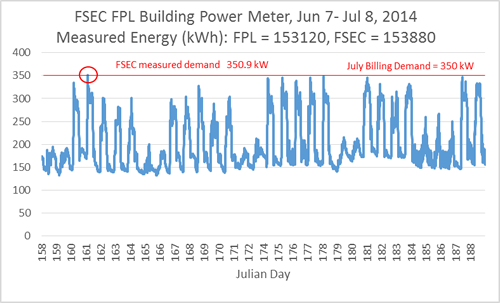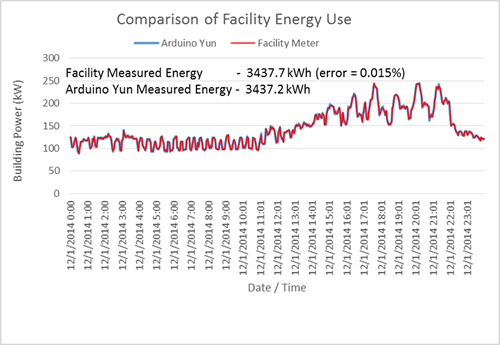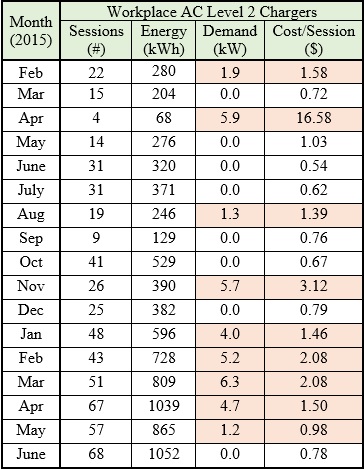Project 11:
Electric Vehicle Grid Experiments and Analysis
Objective
Provide experimental data from vehicle-to-grid laboratory simulations. The results of the experimental data will be used in the EVTC techno-economic simulation project.
Brief Description
This project has concentrated on developing a low cost building energy management system (EMS) and the collection of building energy data to evaluate and verify the EMS functions. The EMS is directed toward the development of processes for reducing peak electrical demand for an office building type. The Florida Solar Energy Center office building was selected for the EMS and data analysis. The inexpensive and developed EMS is applied to five existing EV charging stations for analysis verification. All building and charging station energy use has been continually monitored and recorded. The EMS has been programmed with a predictive control algorithm to minimized building peak loads due to EV charging. Preliminary data shows that demand costs can be minimized or eliminated using simple low cost solutions to controlling building electricity use.
Research Results
The FSEC facility has been instrumented so that energy is measured on a three minute basis through the installation of an FPL utility meter enhancement. Figure 1 represents a comparison between the measured 3-minute facility energy with annotation of the corresponding electric utility billing information. Measured energy is within 0.5% and calculation of the 30-minute running average facility demand agrees within 0.3%.
 |
| Figure 1. Comparison of FPL Billing Information to FSEC Measured Energy Use and Facility Demand |
A second, much less expensive, Linux based data collection device (Arduino Yun) has been installed in parallel with the primary FSEC data recorder and each data recorder measures facility energy use. This miniature computer is connected to the FSEC central server via an Ethernet connection. The FSEC central server computer control system stores information collected from the distributed computers on a central SQL database. The information collected with the EMS system has been compared to historical records of building energy use and agrees within acceptable limits. Figure 2 shows a representative day comparing the measured facility energy from the primary data recorder and that measured using the miniature computer.
 |
| Figure 2. Comparison of Facility Measured Energy and Arduino Yun Duplicate Measurement |
Continued system development has coupled the EMS system to the building energy profile and to the EV charging station demands. These loads were brought together with computers located at each of the three locations and by the EMS system that provides information to a central computer control system. The EMS system follows building loads (primarily monthly peak loads) and makes informed decisions on methods to reduce building peak demand for times when EVs are using the DC fast charger (480V at 60 amp) or other peak loads are occurring.
The EMS uses a predictive control algorithm to attempt to force the workplace charger electricity demand costs toward zero. Preliminary data shows that demand costs can be minimized or eliminated using simple low cost solutions to controlling building electricity use. The following table shows workplace charger statistics collected through June 2016 where electricity demand costs are minimized even though charging station usage has increased. The total power capacity of the FSEC workplace chargers is 12 kW. The EMS system currently maintains less than 6 kW during peak times and further refinement to the predictive algorithm should force this result even lower thereby providing a low electricity cost workplace charger solution.

Future work will continue to develop the control algorithm and include other distributed resources to include a network of facility resources into the EMS system.
Impacts/Benefits
This project has developed a low-cost building EMS that allows the owners or operators of EV workplace chargers to minimize electric utility bills.
REPORTS
Fenton, J. (2015). “Home Energy Efficiency Retrofits and PV Provide Fuel for Our Cars.” The Electrochemical Society Interface. Spring 2016. DOI: 10.1149/2.F02151IF.
Raustad, R. (2015). “The Role of V2G in the Smart Grid of the Future.” The Electrochemical Society Interface. Spring 2016. DOI: 10.1149/2.F04151IF.
Raustad, R. (2018). Electric Vehicle Grid Experiments and Analysis (FSEC Rep No. FSEC-CR-2076-18). Florida Solar Energy Center: Cocoa, FL.
Project Title: University: Principal Investigator: PI Contact Information: Florida Solar Energy Center Funding Source: Total Project Cost: Agency ID or Contract Number: Start date: End date: |
